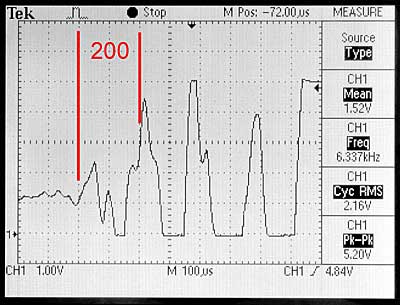|
Measuring Clocks and Watches
The downside of acoustic sensors We have seen some of the unique measurements made possible with acoustic sensors. But when you require precision, you find that the tick sound is not a very accurate signal. In this oscilloscope trace you can see a close up the sound signal, generated by an acoustic sensor, fastened to a clock. The signal starts at a neutral level and gradually builds amplitude in the form of a sound wave. The timing circuit will trigger on this sound only after it reaches a certain threshold. This threshold is commonly around three volts. In this graph, the signal doesn’t reach three volts until 200 microseconds after the sound started. This interval is different on every beat. When you measure a clock with an acoustic transducer, this inconsistency manifests as jitter in the readings. Additionally, an acoustic sensor is vulnerable to false readings caused by other sounds within the clock or surrounding area.
|
